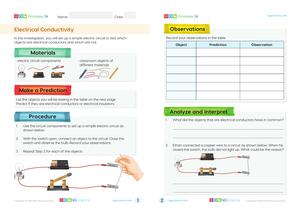Begin the lesson by introducing the concept of heat conductivity using everyday examples like frying pans and wooden spoons. Discuss how different materials react to heat.
Go to the LessonLearning Objectives
- Understand the difference between heat conductors and heat insulators.
- Identify examples of materials that are heat conductors and heat insulators.
- Explain how the materials used in a frying pan utilize heat conductivity and insulation.
- Describe how heat insulators are used in spacecraft design to protect against heat damage.
Introduction and Hook
Engage students with a fun fact about spacecraft design and how heat insulators protect them from extreme temperatures.
Direct Instruction
Explain the difference between heat conductors and insulators with examples such as metal spoons and wooden spoons.
Guided Exploration
Have students explore different materials around the classroom to identify which are conductors and which are insulators.
Guide a discussion on how the properties of materials affect their use in everyday objects, like frying pans and spacecraft.
Hands-On Activity
Conduct an experiment where students test various materials to determine their heat conductivity.
Independent Practice
Assign students to find examples of heat conductors and insulators at home and explain their choices.
Encourage students to draw diagrams of objects like frying pans, labeling the materials and their properties.
Check for Understanding
Ask students to explain how heat insulators are used in spacecraft design, reinforcing the lesson's key points.
Review and Reflection
Review the key concepts of heat conductivity and insulation with the class, encouraging students to share their findings from the independent practice.
Reflect on the importance of choosing the right materials for specific functions, using examples discussed in class.
Assessment and Extension
Conclude with the 'Review – Matter and Materials' assessment to test students' comprehension of the unit.
Try the Quiz




